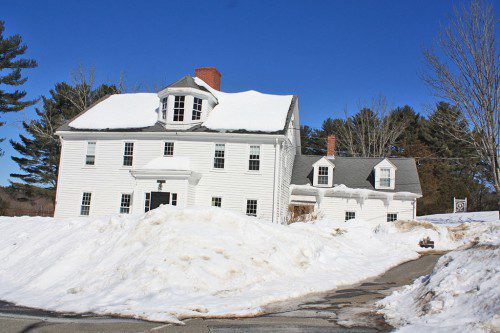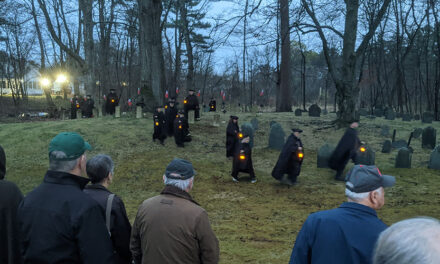
THE WILLIAM SMITH HOUSE at 1282 Main St. on the grounds of the Sagamore Spring Golf Club will be protected from demolition for up to 12 months. The Historical Commission determined it to be a “preferably-preserved Significant Structure.” (Maureen Doherty Photo)
By MAUREEN DOHERTY
LYNNFIELD — The Lynnfield Historical Commission has issued a determination that the William Smith House, located on the grounds of the Sagamore Spring Golf Club at 1282 Main St., is subject to the town’s demolition delay bylaw.
Specifically, the commission has issued a finding to the Sagamore Realty Trust that this house, which dates back to 1721, is a “preferably-preserved Significant Structure and that demolition of this structure would be detrimental to the historical heritage of the town.”
The Historical Commission held a public hearing on Feb. 16 to determine if the town’s demolition delay bylaw applies to this historic resource after being notified of a request to demolish the building.
The commission’s written findings were issued to trustee Richard Luff on Feb. 19 informing the trust that the town’s building inspector “will be notified of this decision and no demolition permit will be issued until one of the conditions set forth in Section 3.8 of the bylaw has been met.”
Under Section 3.8, the commission has up to 12 months to work with the owner to find a person or entity “willing to purchase, preserve, rehabilitate or restore” the home or to find a purchaser who would be willing to remove it and restore it at another location.
The commission indicated in its written findings that its members are looking forward to working with the trust to do just that, as well as “start the search for any applicable grants.”
If no action is taken by the commission within 12 months from the date of its decision, Section 3.8 of the bylaw also allows the applicant to apply for a demolition permit with the building inspector.
The demolition delay may be released sooner than 12 months if the commission provides a written notice to the building inspector that it is satisfied there is “no reasonable likelihood” the owner or another entity is willing to preserve the home or that the owner has made “bona fide” efforts to locate a purchaser to preserve it and has been “unsuccessful.”
As a condition of a demolition delay release, the commission may require the owner to provide “drawings or other documentation for the town’s historic records.”
Historical Commission member Linda Gillon told the Villager that in the near future the commission “will be setting up a meeting with the owners of the building to begin exploring options.”
According to Historical Commission records, the land on which the William Smith House sits has a rich history and was part of a land grant dating back to 1638. A secret room around the chimney known as Cudjoe’s Cave is believed to have been used to hide slaves as part of the underground slave movement to Canada. The home was subsequently used as a summer residence of the commandant of the Boston Navy Yard, Admiral Isaac Cook, who planted a willow tree from Napoleon’s grave on the property. This tree was felled by a storm in 1970.
In 1927, the property was purchased by former big league baseball player Albert I. Strobel and his brother-in-law, Louis K. Luff, to build a golf course, making it one of the first public golf courses in the country.




